K-wire immobilization
1. Principles
Anatomy
The distal phalanx is divided into three anatomical parts: most proximally, the metaphysis, followed by the diaphysis (“shaft”), and finally the ungual tuberosity (“tuft”).
The base of the distal phalanx has a prominent dorsal crest at the insertion of the extensor tendon. The tendon is also adherent to the distal interphalangeal (DIP) joint capsule.
On the palmar surface is the insertion of the flexor digitorum profundus tendon. This is also adherent to the volar plate.
The flexor tendon inserts into the whole width of the base of the distal phalanx.
The volar plate is very flexible, allowing hyperextension of the DIP joint and pulp-to-pulp pinch.
The vascularity of the extensor tendons is more precarious than that of the flexor tendons. This prolongs extensor tendon healing time.
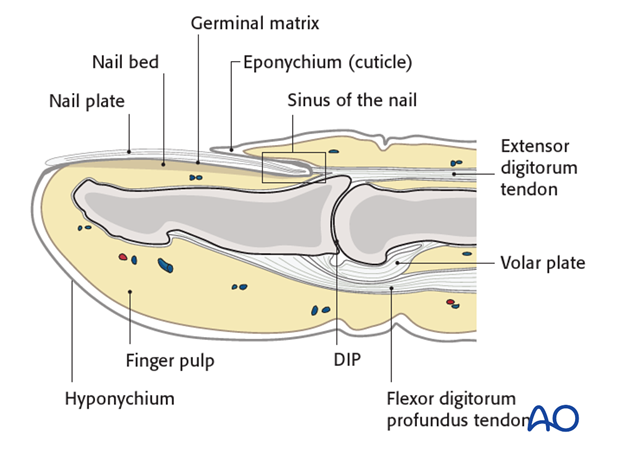
Diagnosis
Discontinuities of the extensor insertion are often referred to as “mallet injury” or “baseball finger”. They can be purely tendinous, or bony avulsion fractures.
Diagnosis is based on
- The clinical history of the trauma
- Deformity, pain and swelling located in the dorsal aspect of the DIP joint
- Inability actively and fully to extend the DIP joint
- X-rays
AP and true lateral x-rays of the DIP joint are necessary for the diagnosis of fracture avulsions.
Low-energy radiographs, as used to visualize soft tissues, can be useful in identifying small flakes of bone.
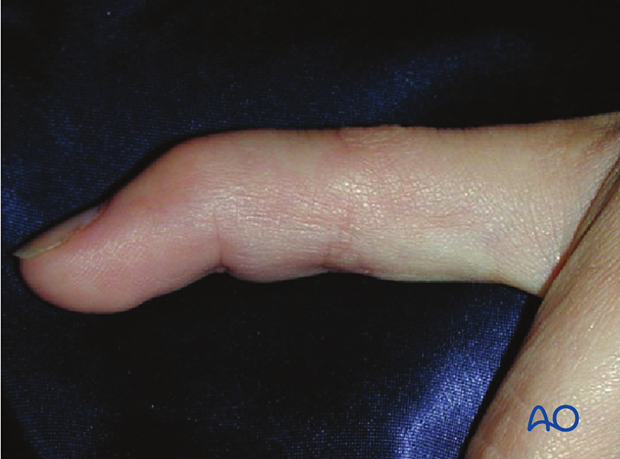
Flexion injury
The commonest cause of these injuries is forcible flexion of the actively extended DIP joint, as when stubbing a straight finger against resistance.
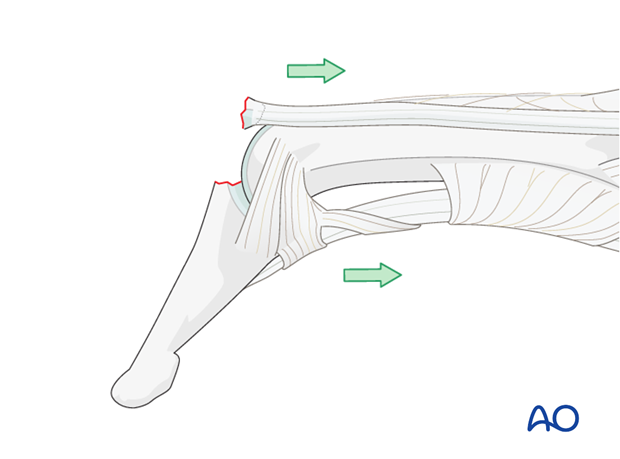
Axial compression injury
Occasionally, the injury is the result of an axial overload of the terminal segment of the finger, causing joint impaction and a dorsal marginal fracture, which is retracted by the pull of the extensor tendon.

Spectrum of injury – partial disruption
These injuries may be complete disruptions or partial disruptions.
The nature of the disruption may be either a tear of the tendon insertion without fracture, or a bony avulsion of the tendon from the dorsum of the base of the distal phalanx, the bony fragment being of variable size.
In incomplete tendon injuries the resulting extension lag is no greater than 30 degrees. The patient retains a partial ability actively to extend the DIP joint.
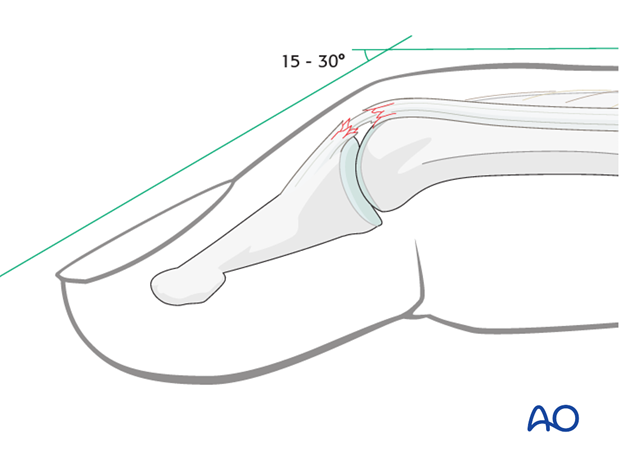
Spectrum of injury – complete disruption
In complete disruption of extensor mechanism, the patient is unable actively to extend the DIP joint.
The flexor digitorum profundus exerts a flexion deforming force onto the distal phalanx, partly counterbalanced by the intact oblique retinacular ligaments and the collateral ligaments.

A similar clinical picture is presented by bony avulsion of the extensor mechanism at its insertion. The dorsally avulsed fragment is of variable size.
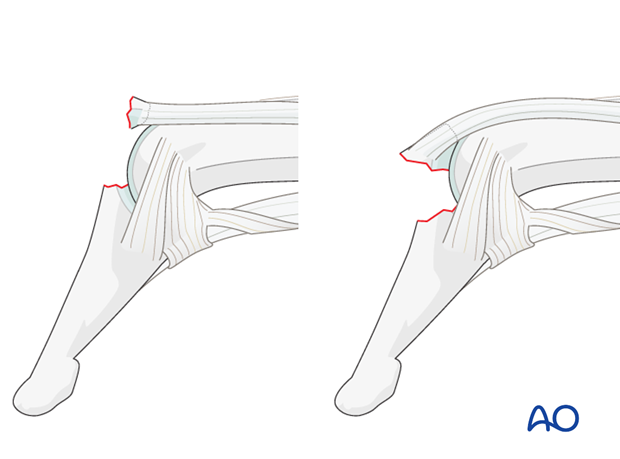
Swan-neck deformity
In some patients, elasticity of the ligaments and a lax PIP joint can result in swan-neck deformity, because after disruption of the extensor mechanism at the DIP joint, all extensor forces are concentrated on the PIP joint.
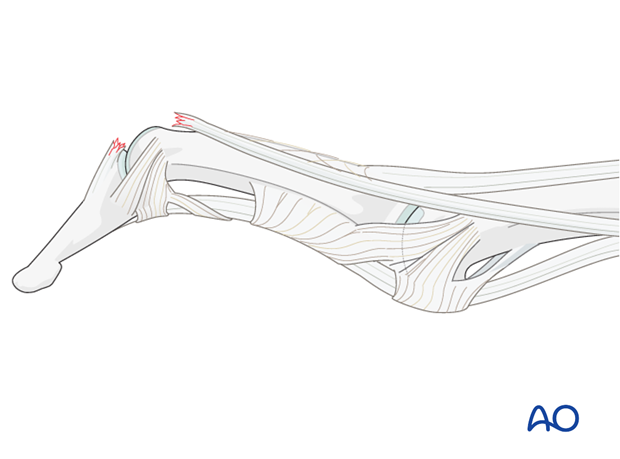
Fracture subluxation of DIP joint
An obliquely orientated axial compression force sometimes results in a dorsal marginal fracture, involving approximately half the articular surface, and can disrupt the collateral ligaments.
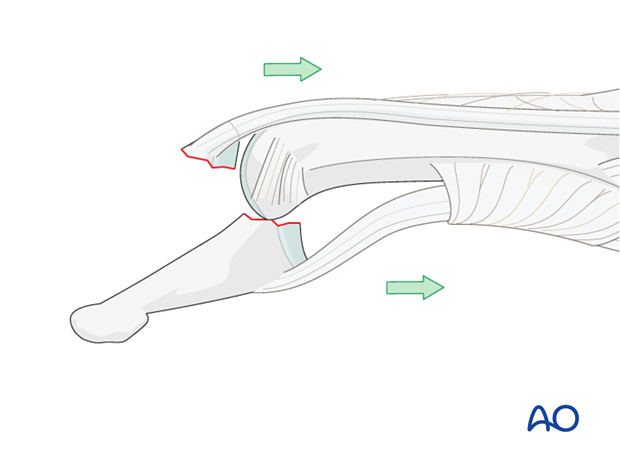
In such instances the pull of the flexor digitorum profundus results in palmar subluxation of the distal phalanx.
This injury represents a strong indication for ORIF.

2. Operative treatment: caveat
Surgical management of these fractures is difficult and has many potential complications. The soft tissues are only precariously vascularized, and the fragments are very small and prone to further comminution. Healing can often be slow.
Inexperienced handling of this area may harm the germinative matrix of the nail and cause permanent deformity.
Consider that nonoperative treatment is almost always a viable alternative in these fractures, often with comparable results. Operative treatment should only be attempted by experienced hand surgeons, in selected cases.
Absolute indications for surgical intervention are:
- Open fractures
- Palmar subluxation of the DIP joint
It is wise always to use magnifying loupes in these surgical procedures.
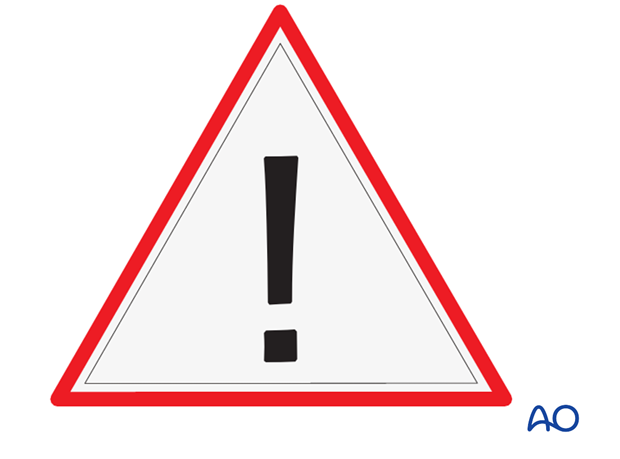
3. Indications for surgical immobilization
Immobilization of the DIP joint can be achieved not only by splintage, but also by using a transarticular K-wire.
Splintage works best in compliant patients, who are willing and able to follow instructions for cleaning and splint changing.
The indications for K-wire immobilization of the DIP joint are:
- high-demand patients who need to return to work as soon as possible
- patient preference
Potential risks of percutaneous pinning
The commonest risk of percutaneous K-wire immobilization is infection. Two precautionary measures can reduce this risk:
- perform the surgical intervention in an adequately aseptic environment
- cut and bend the K-wire to leave it flush with the tip of the bone, eliminating the risk of irritation and of pin-track infection in protruding K-wires.
Breakage of the K-wire at the level of the DIP joint can be avoided by using a wire of at least a 1.0 mm diameter and counselling the patient to avoid stresses at the DIP joint.
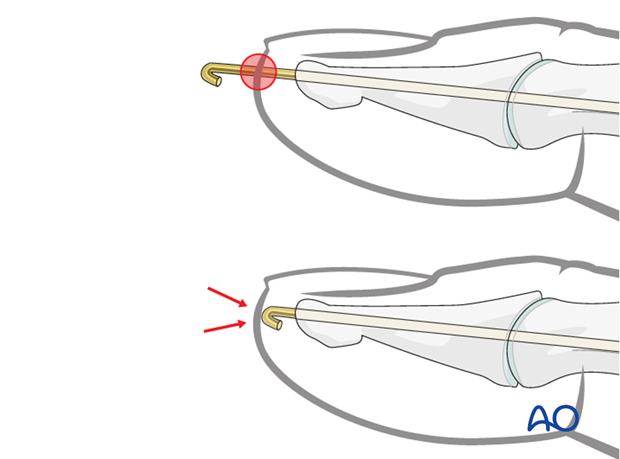
4. Preparation and approach
Marking K-wire track
In order to avoid unnecessary radiation from image intensification, mark the planned track of the K-wire with a skin marker (or methylene blue) on the distal phalanx in both the AP and the lateral aspects.

Approach
For this procedure a percutaneous approach through the finger tip is normally used.

5. Inserting the K-wire
Pitfall: slipping K-wire
Due to the conical shape of the tip of the distal phalanx, there is a risk of slippage of the K-wire, either in a lateral, palmar, or dorsal direction.
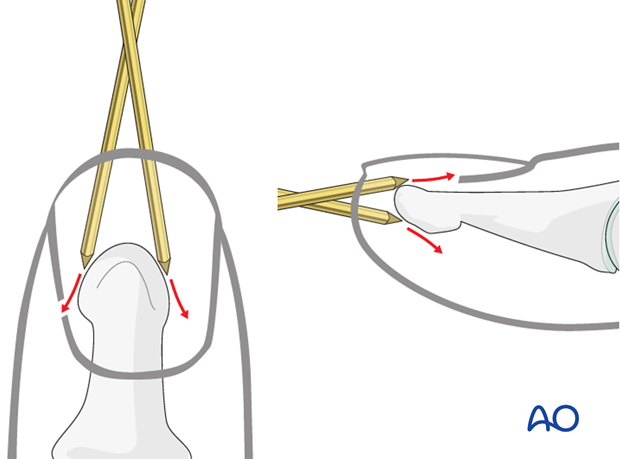
Pearl: preventing skidding
To prevent the K-wire from skidding during insertion, either a 16 gauge hypodermic needle, or a 1.0 mm drill guide, can be used. Each finds good purchase on the tip of the distal phalanx and will ensure that the K-wire is inserted in the center and along the longitudinal axis of the phalanx.
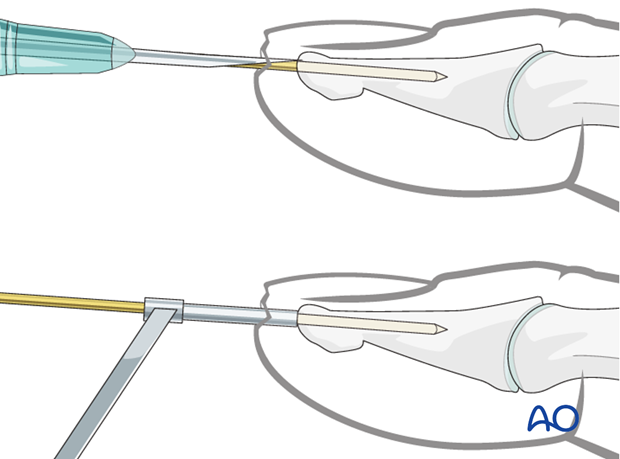
Pitfall: K-wire in wrong plane
If a K-wire is mistakenly inserted at an angle to the axis of the phalanx, we recommend leaving it in until a second K-wire has been inserted in the correct orientation. This will prevent the wire from going unintentionally along the wrong track.
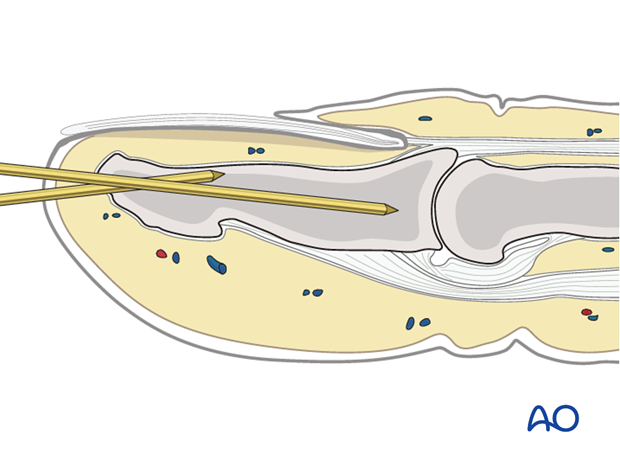
Fully insert the K-wire
The K-wire is now advanced through the DIP joint into the middle phalanx, as far as its base. Be careful not to penetrate the PIP joint.

Cut the K-wire
Cut the K-wire just distal of the tip of the distal phalanx. Retract it by about 5 mm, bend it through approximately 100 degrees, to adapt it to the convex shape of the tip of the distal phalanx, and twist it in an ulnar direction to avoid soft-tissue irritation.
The ulnar alignment of the bent K-wire tip has the advantage that most of the finger‘s pinch involves the radial and palmar aspects.
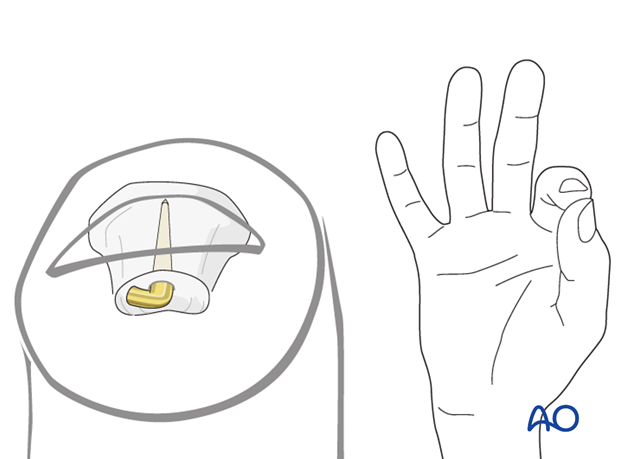
6. Aftertreatment
Postoperatively
After K-wire fixation, the DIP joint has to be immobilized in extension, leaving the PIP joint free.
While the patient is in bed, use pillows to keep the hand elevated above the level of the heart to reduce swelling.

A splint protects the injury for 7 days.
A night splint is employed for 4 weeks. Wearing the splint for heavy-duty activities is recommended as added protection.
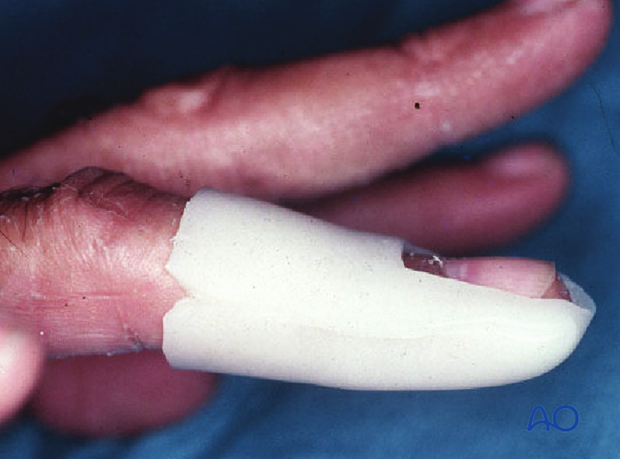
For ambulant patients, put the arm in a sling and elevate to heart level for a few days.
Instruct the patient to lift the hand regularly overhead, in order to mobilize the shoulder and elbow joints.
Mobilization of the PIP and MCP joints is encouraged from the beginning.

Duration of immobilization
The DIP joint remains immobilized for 8 weeks before the splint and K-wire are removed.
Instruct the patient to avoid sporting activities involving the hand for a duration of 3 months.
Follow up
See the patient 5 days and 10 days after surgery.
Implant removal
The K-wire is removed under local anesthesia after 8 weeks.













